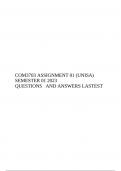Exam (elaborations)
COM3703 ASSIGNMENT 01 (UNISA) SEMESTER 01 2023 QUESTIONS AND ANSWERS LASTEST
- Course
- Institution
COM3703 ASSIGNMENT 01 (UNISA) SEMESTER 01 2023 QUESTIONS AND ANSWERS LASTEST.1. INTRODUCTION........................................................................................................................................1 2. QUANTITATIVE CONTENT ANALYSIS.....................................
[Show more]



